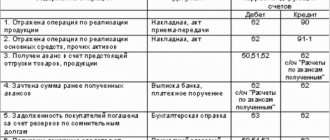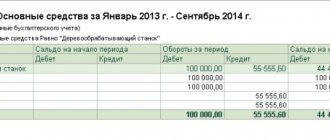Account 68 in accounting
Account 68 is credited for amounts according to tax returns or calculations in correspondence:
- Account 99 - for the amount of accrued income tax;
- Invoice 70 - for the amount of personal income tax;
- Accounts 20, 25, 26, 44 - for the amount of local taxes, transport tax, property tax, etc.;
- Accounts 90.3, 91.2, 76.AV - when calculating VAT for the reporting quarter;
- Invoice 51 - upon receipt of overpaid tax from the budget.
The debit of the account records the amounts of taxes actually transferred to the budget, including the amounts of VAT written off from account 19.
Account characteristics/description:
Subaccount 68.04.1 “Settlements with the budget” is intended to summarize information on settlements with the budget for income (profit) tax of organizations.
This account does not reflect the details of the calculation of the amount of income tax made in accordance with PBU 18/02 “Accounting for income tax calculations”. Organizations that do not apply the provisions of PBU 18/02 reflect the accrual of income tax amounts payable to the budget (or reduction of amounts due for payment to the budget) on this subaccount in correspondence with account 99.01 “Profits and losses”. Organizations applying the provisions of PBU 18/02 reflect the accrual of current income tax amounts payable to the budget (or reduction of amounts due for payment to the budget) in this subaccount in correspondence with subaccount 68.04.2 “Calculation of income tax.” Analytical accounting is carried out for budgets into which the tax is to be credited (sub-account “Budget Levels”). Subconto can take the following values: - “Federal budget”, - “Regional budget”, - “Local budget”. Description of the parent account: Description of account 68.04 “Income Tax”
Subaccounts 68 “Calculations for taxes and fees”
Subaccounts under account 68 are used for taxes and fees paid by the company, depending on its chosen field of activity and tax regime. In this case, a separate sub-account is opened for each type of tax:
Additional sub-accounts can also be opened under account 68:
- 68.11 - UTII;
- 68.12 – simplified tax system;
- 68.13 – Trade fee.
Synthetic and analytical accounting of calculations for personal income tax.
In all cases, the amounts of turnover on the credit of account 68 are reflected in correspondence with the debited accounts.
At the end of the month, by debit, the totals for the month and the balance at the beginning of the next month are read for certain debtors (creditors) and for the statement as a whole. Turnovers on the credit of accounts for the month in the context of corresponding accounts are transferred to the journal order No. 8.
Synthetic accounting for account 68 “Calculations for taxes and fees” is carried out in the current balance sheet, where balances and turnovers from the turnover sheet for analytical accounts are recorded. The results of the turnover sheet for analytical accounts are compared with the results of the corresponding synthetic account - they must be equal.
Typical wiring
The main transactions for this account are presented in the table:
| Account Dt | Kt account | Wiring Description | A document base |
| 68 | 19 | Amounts of taxes actually transferred to the budget + VAT | Payment order |
| 68 | 50/51,52,55 | Payment of tax debts in cash or through a bank | Payment order |
| 70/75 | 68 | Personal income tax withheld from the income of employees or founders | Payslip |
| Based on settlement amounts for contributions to budgets | |||
| 99 | 68 | Income tax is reflected | Help-calculation |
| 70 | 68 | We reflect the amount of accrued personal income tax | Payslip |
| 90 | 68 | We reflect VAT, excise taxes, indirect taxes | Accounting information |
| 91 | 68 | We reflect financial results (operating expenses) | Certificate of calculation/Acceptance and transfer certificate |
Example 1. Postings to subaccount 68.01 “NDFL”
Let’s say that at the end of the month, at Osen LLC, an accountant assessed personal income tax on employee salaries in the amount of 107,256 rubles. Dividends were also paid to the founders, the tax amount was 65,123 rubles.
Postings for calculating personal income tax on account 68:
| Account Dt | Kt account | Transaction amount, rub. | Wiring Description | A document base |
| 70 | 68.01 | 107 256 | Personal income tax accrued on salary | Payslip |
| 75.02 | 68.01 | 65 123 | Personal income tax accrued on dividends | Tax card for personal income tax, accounting certificate |
| 68.01 | 51 | 107 256 | Personal income tax on wages transferred to the budget | Payment order |
| 68.01 | 51 | 65 123 | Personal income tax on dividends transferred to the budget | Payment order |
Example 2. Postings to subaccount 68.02 “VAT”
At Leto LLC based on the results of the 2nd quarter (core activities):
- VAT was charged in the amount of RUB 78,958;
- VAT accepted for deduction (advance) in the previous quarter in the amount of RUB 36,695 was restored;
- VAT on the sale of fixed assets amounted to RUB 7,959.
The accountant of Leto LLC reflected the accrual of VAT with the following entries:
| Account Dt | Kt account | Transaction amount, rub. | Wiring Description | A document base |
| 90.03 | 68.02 | 78 958 | VAT charged (sales) | Accounting information |
| 76 advance | 68.02 | 36 695 | VAT restored | Sales book |
| 91.02 | 68.02 | 7 959 | VAT charged (VAT) | Certificate of acceptance and transfer |
| 68.02 | 51 | 123 612 | The tax is transferred to the budget | Payment order |
Account 68 in accounting
68 accounting account is intended to carry out the procedure for summarizing information on complete calculations of fees and taxes. This takes into account not only payments sent to the budget, but also taxes paid by the company’s employees.
Drawing up reports
To make a correct account analysis, you need to take into account all types of interest rates by type of taxation. Its peculiarity is that it is both passive and active at the same time. This is influenced by the data that should be displayed on it.
Important! Filling out account documentation has its own characteristics. In addition, there are special formulas for calculating personal income tax.
general description
On account 68.02 “VAT” in the chart of accounts, we collect “ information” about all calculations for VAT tax (tax accrual, tax payment).
If we need to find out all the information about how the VAT tax was “calculated”, how the VAT tax was “paid”, then we can safely study account 68.02 using basic reports in the 1C program (turnover balance sheet, account analysis, account card).
The account reflects all transactions to charge VAT to the budget, as well as transactions to reduce VAT previously paid to suppliers of goods and services. I will not dwell on the rationale for such operations; in general, based on the analysis of account 68.02, the document “VAT Declaration” is drawn up. The account is used very often if your organization is a VAT payer.
Reverse balance sheet for account 68
On debit, data on actual transfers of the organization is collected. In addition, VAT amounts presented by suppliers and accepted for deduction (from Kt19) and credited advances from buyers (from Kt76AV) are transferred to Debit account 68.
Attention! Balances on account 68 must coincide with the settlement certificate for mutual settlements ordered from the Federal Tax Service.
Calculations for each tax are analyzed separately, therefore, separate sub-accounts 68 accounts are opened in accounting:
68.01 – mutual settlements with the budget as a tax agent are taken into account when transferring personal income tax from employee salaries;
68.02 – VAT
68.03 – excise taxes;
68.04 – data on advance payments and annual tax calculation on the profit received by the company is displayed here. The payment is distributed between the federal and regional budgets.
Something to keep in mind! Organizations operating in accordance with PBU 18/02 must open an additional sub-account to reflect information on the calculation of advance payments.
68.07 – display of information about transport tax;
68.08 – property taxes;
68.09 – tax payments on advertising
68.10 – other types of taxes and fees
68.11 – UTII (for business entities who have chosen this form of taxation);
68.12 – simplified tax system (for business entities who have chosen this form of taxation);
68.13 – information on trading fees
68.22 – this sub-account records information on possible VAT refunds on exports if it is necessary to obtain additional permission from regulatory authorities (the sub-account is active)
68.32 – data on VAT transfers if the company acts as a tax agent (passive subaccount)
Account 68 “Calculations for taxes and fees” - subaccounts, postings
A deferred tax asset upon disposal of the asset for which it was accrued is written off from the credit of account 09 “Deferred tax assets” to the debit of account 99 “Profits and losses”.
Subaccount 68.12 is used in accounting by organizations and individual entrepreneurs that are on a simplified taxation system to reflect transactions based on single tax amounts.
Count 68 is active-passive. The loan displays the amounts accrued for payment to regulatory authorities in accordance with the declarations provided in correspondence with the corresponding accounting accounts (for example, employee compensation, profits and losses, etc.). On debit, data on actual transfers of the organization is collected.
Organizations operating in accordance with PBU 18/02 must open an additional sub-account to reflect information on the calculation of advance payments.
If an organization owns vehicles on which transport tax is paid, then subaccount 68.7 is used. Account 68 Calculations for taxes and fees is intended to summarize information about settlements with budgets for taxes and fees paid by the organization, and taxes with employees. Let us recall the procedure for using accounts in accounting.
At the same time, debt for settlements with buyers, customers and other debtors, secured by overdue bills of exchange, continues to be recorded in accounts receivable accounts.
Accounting for calculations of taxes and fees is carried out on account 68, which reflects the accrual of taxes and their payment to the budget.
Count 68 – active or passive?
For the amounts spent by accountable persons, account 71 “Settlements with accountable persons” is credited in correspondence with the accounts that record expenses and acquired values, or other accounts depending on the nature of the expenses incurred.
The use of account 68 to display information on mutual settlements with budgets of various levels in terms of taxes and fees paid is carried out in accordance with the current Chart of Accounts, approved by Order of the Ministry of Finance dated October 31, 2000 No. 94, and other legislative acts.
How to take taxes into account in accounting? For this, account 68 “Calculations for taxes and fees” is used. This is a passive account designed to summarize information about the company’s settlements with government budgets of all levels.
Account 68 - common accounting entries
Accounting for tax amounts is necessary to monitor the fulfillment of the enterprise’s obligations to pay taxes to the budget. Account 68 is used to reflect tax transactions.
Subsequently, these amounts are written off from account 94 “Shortages and losses from damage to valuables” to the debit of account 70 “Settlements with personnel for wages” (if they can be deducted from the employee’s wages) or 73 “Settlements with personnel for other operations” ( when they cannot be deducted from the employee’s wages).
In particular, for the calculation and payment of personal income tax (abbreviated as personal income tax or income tax, as people like to call it), a subaccount 68.1 is opened. The procedure for calculating VAT depends on the type of operations that were carried out by the enterprise (sale/free transfer of goods, construction and installation works on its own, advances received, unconfirmed exports, etc.) Let's consider typical entries for reflecting the amount of VAT depending on the type of operations performed.
Account 68 in accounting is intended to collect information about mutual settlements on accrued tax payments required for payment to budgets, the organization's debts to regulatory authorities and identified amounts of overpayments. The legislation provides for differentiated tax rates for different regions and constituent entities of the Russian Federation. The rate range (from 5% to 15%) is determined depending on the category of payer (range from 5% to 15%).
Is count 68 active or passive? this account can have both a debit and a credit balance. It all depends on the nature of the debt. If there is an overpayment of taxes, then the balance is a debit. In case of debt to budgets - credit.
The accounts of this section are intended to summarize information on the availability and movement of objects of labor intended for processing, processing or use in production or for economic needs, means of labor, which, in accordance with the established procedure, are included in the composition of funds in circulation, as well as operations related to their procurement (purchase).
Account 68-VAT - Calculations for taxes and duties
Analytical accounting of deferred tax assets is carried out by type of asset or liability in the valuation of which a temporary difference arose. The debit of account 68 in the accounting records reflects the amounts actually transferred to the budget, as well as the amounts of value added tax written off from account 19 “Value added tax on acquired assets.”
Moreover, if bonds are placed at a price exceeding their nominal value, then entries are made in the debit of account 51 “Current accounts”, etc. in correspondence with accounts 67 “Settlements for long-term loans and borrowings” (at the nominal value of bonds) and 98 “Income future periods" (by the amount of excess of the bond placement price over their nominal value). The amount allocated to account 98 “Deferred income” is written off evenly during the circulation period of the bonds to account 91 “Other income and expenses”.
Accounting: account 68 “Calculations for taxes and fees”
Synthetic tax accounting is maintained in account 68 “Calculations for taxes and fees.” Analytical accounting is carried out by types of taxes.
Account 68 is an accounting account that is used to summarize information on taxes and fees. Analytical accounting of the account is carried out by types of taxes. Therefore, for each type of tax you need to open your own subaccount.
In the article we will talk about the accounting rules for account 68, and also look at typical entries in tables and examples of transactions with VAT, as one of the most difficult taxes to account for.
At the same time, debt for settlements with buyers, customers and other debtors, secured by an overdue bill of exchange, continues to be recorded in the corresponding accounts receivable.







